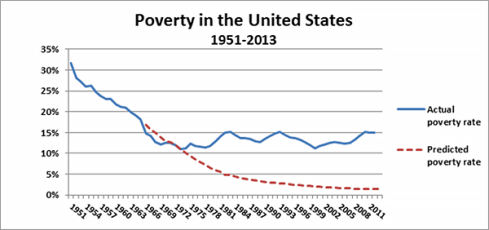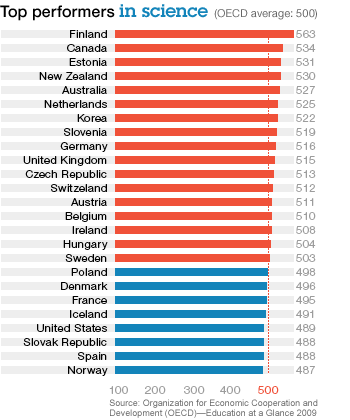I was reading a New York Times editorial by David Brooks. He quoted Branko Milanovic, an economist, on what has happened to a number of countries in Eastern Europe since the fall of the Soviet Union — on the fact that these countries have not thrived since 1989:
“Basically,” Milanovic writes, these “are countries with at least three to four wasted generations. At current rates of growth, it might take them some 50 or 60 years — longer than they were under communism! — to go back to the income levels they had at the fall of communism.”
In Milanovic’s view, those countries had spent decades driving themselves into a hole, or being driven there, and were going to spend decades finding their way back out.
It occurred to me that this was probably what people would be saying about the United States, some years from now. The contrasts between the U.S. and countries like Sweden have become increasingly dramatic. The following discussion provides some examples, and then suggests some conclusions.
First, this graph from the Henry J. Kaiser Family Foundation shows that healthcare spending per capita in the U.S. has been more than twice that of Sweden.
And yet, for many years now, all that money has been achieving inferior healthcare results. As of 2009 — at the height of American global dominance as the sole superpower — this graph from the Washington Post shows infant mortality in the U.S. averaging nearly three times the rate of Sweden:
Life expectancy at birth is equally dismal in the U.S. compared to other advanced nations, as indicated in this graph from The Atlantic:
The contrast between the U.S. and other nations — nations that were far behind us in the postwar years — appears in areas beyond healthcare. For example, the next chart, from the Canadian Office of Consumer Affairs, shows that Sweden far outstrips the U.S. and Canada in literacy. This is especially visible in the much smaller percentage of the Swedish population that remains stuck at the lowest literacy levels, at the left side of the chart:
The fundamentally messed-up nature of our society, including notably its approach to matters of justice and mental health, is evident in data on the ways in which we die. Consider this graph, from Our World in Data, comparing homicide rates in the U.S. and England:
As another example in that vein, consider the rates of road fatalities that we tolerate. This SSTI chart shows fatalities per million inhabitants per year:
Declining, yes — to such a point that we are almost where Japan was, 20 years ago.
The point is clear enough. We have gone off track. This is not a new development — attributable, say, to George Bush or Barack Obama. This has been a long-term process.
People have lately been paying more attention to inequality as a cause of such poor outcomes. And it is true: the U.S. continues to become more like some developing nations, in its gap between rich and poor. As indicated in this chart from the Council on Economic Advisers, the American rich now dominate national income at levels not seen since the Great Depression and, again, far above the level of Sweden:
To amplify one aspect of the preceding chart, the U.S. at its best has been less equal than Sweden at its worst (source: William Domhoff):
Again, though, the resulting poverty levels are nothing new: we have tolerated them, and they have remained stubbornly level, for at least two generations, as shown by the Independent Institute:
Other posts in this blog indicate the core of problem. For one thing, you cannot treat your people like trash. This is not a corporation, where such things are pathologically accepted as normal. This is a country. Everyone has a right to be here and to live like a human being, at least until we toss out our founding documents. And that’s what they enforce in happy, relatively socialistic countries like Sweden (source: Gallup):
Small wonder that, several years ago, observers began to realize that the American Dream had moved to Denmark.
We could change directions. Doing so would require attention to how we are governed. The fact that we should all be able to live here freely and happily does not imply a moral entitlement to make decisions on matters that we do not understand. As discussed in another post, good government depends upon qualified decisionmaking. We have been blowing our money and running our country into the ground because we have been steered by frauds, fools, and crazies — and because we continue to tolerate and exacerbate that.
Without fundamental change on the level of a constitutional convention, that will not change anytime soon. We will have better presidents and worse presidents; we may have an effective and well-informed Congress once in a while; but for the most part we appear to be set to continue on our downhill slide. Like Eastern Europe after 1989, things will apparently have to get worse before they get better — before people finally get serious about putting the nation in order.
After quoting Branko Milanovic (above), David Brooks argued that the difference between successful and failing countries in Eastern Europe is that some made better political decisions; some quickly engaged in radical reforms that were painful in the short term but produced “much more prosperity over the long run”; some made a more determined effort to develop solid fundamentals (perhaps including what we call infrastructure); and some based their efforts on solid and deeply felt values. And then there were those that failed to take some or any of those steps.
On the particular topic of deeply felt values, Brooks cites Poland for its commitment to “a clear sense of justice and injustice,” born of many, many years of victimization. To cite one more of my previous posts, the U.S. remains very far from any such commitment.
The idea that Poland would surpass the U.S. in anything of importance would have been unthinkable thirty years ago. It is no longer unthinkable; Poland does now enjoy superiority in certain regards, as illustrated in this IBM chart:
By 2030, what they say about us will be what people like Brooks and Milanovic are now saying about Poland’s less determined neighbors: we have been digging ourselves into a hole for generations, and it is not clear when we will find our way out.
There is one particularly worrisome possibility in that assessment. Quoting again from Brooks, “When everything seems arbitrary and crooked, people tolerate strongman rule.” Brooks’s point is that the less successful nations of Eastern Europe have reacted against horrendous conditions by accepting if not craving the promise and the focus of an authoritarian leader. In his words, “Those without power hanker for security at all costs.” It was unthinkable, thirty years ago, that the people of the U.S. would ever desire a strong leader who would cut through the logjams and get things done. Even without a natural or manmade catastrophe to drive us in that direction, I am concerned that, come 2030, we may be only halfway through a century-long decline.












Leave a comment